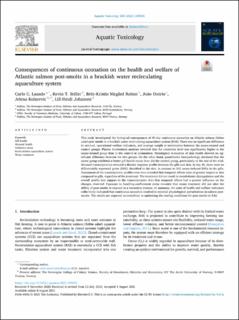| dc.contributor.author | Lazado, Carlo C. | |
| dc.contributor.author | Stiller, Kevin Torben | |
| dc.contributor.author | Reiten, Britt Kristin Megård | |
| dc.contributor.author | Osório, João | |
| dc.contributor.author | Kolarevic, Jelena | |
| dc.contributor.author | Johansen, Lill-Heidi | |
| dc.date.accessioned | 2021-08-26T09:20:17Z | |
| dc.date.available | 2021-08-26T09:20:17Z | |
| dc.date.created | 2021-08-08T19:55:07Z | |
| dc.date.issued | 2021 | |
| dc.identifier.citation | Aquatic Toxicology. 2021, 238 1-11. | |
| dc.identifier.issn | 0166-445X | |
| dc.identifier.uri | https://hdl.handle.net/11250/2771345 | |
| dc.description.abstract | This study investigated the biological consequences of 45-day continuous ozonation on Atlantic salmon (Salmo salar) post-smolts in a brackish water recirculating aquaculture system (RAS). There was no significant difference in survival, operational welfare indicators, and average weight at termination between the ozone-treated and control groups. Plasma biochemical analyses revealed that the creatinine level was significantly higher in the ozone-treated group than in the control at termination. Histological evaluation of skin health showed no significant difference between the two groups. On the other hand, quantitative histopathology disclosed that the ozone group exhibited a better gill health status than did the control group, particularly at the end of the trial. Mucosal transcriptomics revealed a distinct response profile between the gills and skin. At day 45, there were no differentially expressed genes (DEG) identified in the skin, in contrast to 242 ozone-induced DEGs in the gills. Assessment of the transcriptomic profiles over time revealed that temporal effects were of greater impact in skin compared to gills, regardless of the treatment. The treatment did not result in metabolomic dysregulation and the overall profile lent support to the transcriptomics data that temporal effects had a greater influence on the changes observed. Exposure to handling-confinement stress revealed that ozone treatment did not alter the ability of post-smolts to respond to a secondary stressor. In summary, the suite of health and welfare indicators collectively indicated that continuous ozonation resulted in minimal physiological perturbations in salmon post-smolts. The results are expected to contribute to optimising the rearing conditions for post-smolts in RAS. | |
| dc.language.iso | eng | |
| dc.title | Consequences of continuous ozonation on the health and welfare of Atlantic salmon post-smolts in brackish water recirculating aquaculture system | |
| dc.type | Peer reviewed | |
| dc.type | Journal article | |
| dc.description.version | publishedVersion | |
| dc.source.pagenumber | 1-11 | |
| dc.source.volume | 238 | |
| dc.source.journal | Aquatic Toxicology | |
| dc.identifier.doi | 10.1016/j.aquatox.2021.105935 | |
| dc.identifier.cristin | 1924592 | |
| dc.relation.project | Norges forskningsråd: 237856 | |
| cristin.ispublished | true | |
| cristin.fulltext | original | |
| cristin.qualitycode | 2 | |
